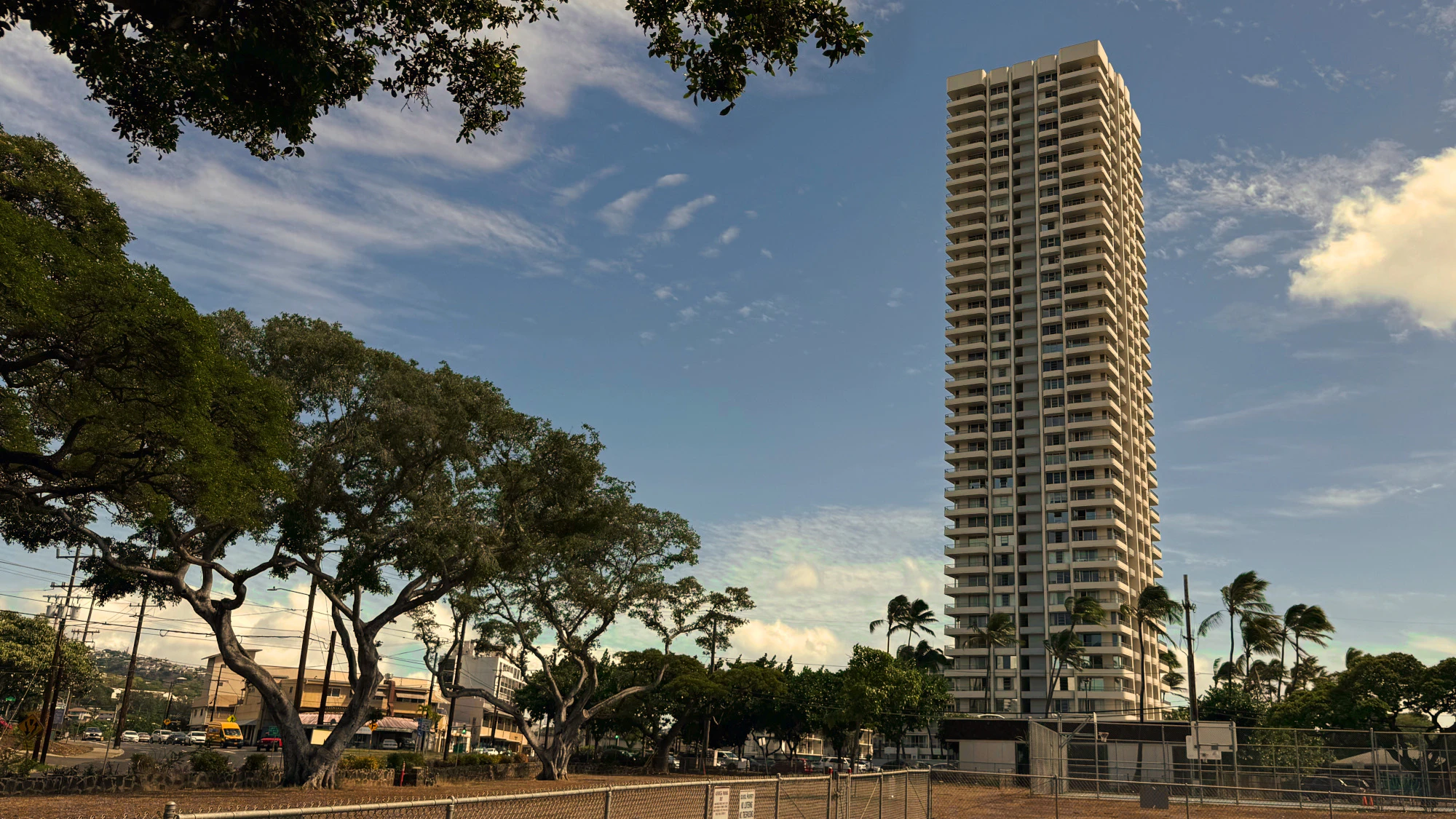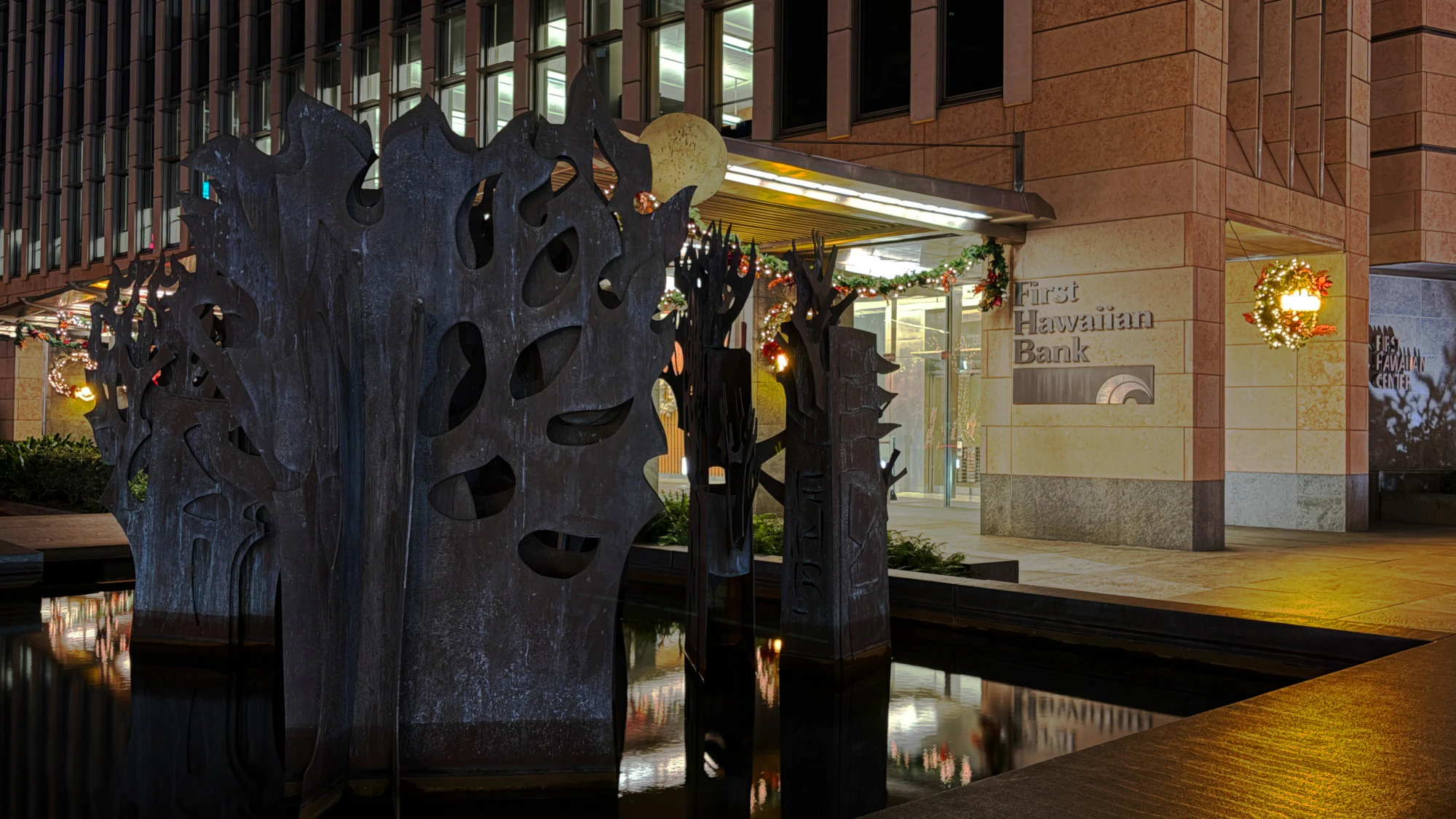Located about two miles from Downtown Honolulu, the neighborhood of Mo‘ili‘ili was once primarily agricultural. Rice paddies and lo‘i kalo occupied most of the land, with houses and small businesses scattered about. By the 1960s, apartment buildings, grocery stores, and small shopping centers attracted more people seeking a quieter life while still wanting to remain close to Honolulu. The Mo‘ili‘ili community was tightly knit and soon became known as the floral capital of Honolulu as demand for lei and daily flower bouquets grew.
One gathering place for the Mo‘ili‘ili community was the Kamo‘ili‘ili Church, whose congregation was predominantly Hawaiian. Construction for the simple stone church began in 1850 and was completed three years later. Although the building was restored around 1900 and renamed Rice Memorial Chapel, many in the community continued to call it Kamo‘ili‘ili Church.
In addition to Sunday services, the hallowed building saw weddings, funerals, celebrations, and community meetings throughout its life. For a time, it even served as a Masonic hall to the Cosmopolitan Lodge of the Prince Hall Lodge of African American Freemasons in Hawaii.
A woman I know recalls time spent there as a child, waiting for her parents. With no babysitter at the time, she would have to stay in a small room by herself, where she was left to play, color, or find something else to keep herself busy. In a separate room, her father and the rest of his Prince Hall brothers would have their lodge meetings. In another room was her mother, who would attend the meetings of the Order of the Eastern Star with the other wives of Masonic husbands.
One evening, as a girl, she noticed a Hawaiian man looking in the window from outside. He had dark hair and a beard, thick eyebrows and full lips, and he wasn’t wearing a shirt. The man’s intense gaze was frightening as he pointed to the screen covering the window, indicating that he wanted her to open it. Without speaking, she shook her head, “No.”
Despite her refusal to cooperate, the hook holding the screen popped off on its own, and the man pulled the screen back. My friend said she remembers hearing a blood-curdling scream before realizing it was coming from her. She ran into the men’s lodge meeting and found the masons in a state of upset and confusion. They had apparently seen a Hawaiian man peering in at them from a window high up on the far wall. No outsider could bear witness to a solemn masonic ceremony, so the men went outside to chase the stranger away. They never found anyone hanging around outside, but did note that the window he peered into was nine feet off the ground with no crate, stone, or foothold to climb on.
As time marched on, the church fell into disuse and then disrepair, and was condemned by the city. While the building sat empty, the graveyard, too, had gone untended. In 1968, plans for a new high-rise were announced, and the land beneath the century-old cemetery was chosen for development. Newspapers cited weeds covering gravestones, some of which were broken or leaning awkwardly. Trash had gathered near several plots, more than one tomb was cracked and crumbling, and several markers had already disappeared.
Although the last burial was in the 1950s, letters to newspapers expressed mourning for the loss of history and lament for the irreversible change. One writer posed a warning to other congregations that they may not be exempt from such bittersweet progress in the future.
Work to remove gravestones began in August 1968. Reverend Abraham Akaka of Kawaiaha‘o Church acknowledged the tension between history and progress. He reminded those gathered that every civilization advances by giving up some of its past, saying that growth often demands “selling something of the soul.”
Over the following weeks, workers uncovered the remains of 466 people. Of those remains, 206 were identified, while the rest will forever be unknown. Some graves held the bones of parents and children, while others contained only ashes. The remains were placed in small containers and reburied at Kawaiahaʻo Church in a shared resting place marked by a plaque listing the known names. Above the memorial hangs the bell that once rang from the steeple at Kamoʻiliʻili Church.
But that wasn’t the end of it.
In November, Reverend Akaka returned to the site to perform special purification rites. The special blessing was requested because workers were reluctant to enter the area. Using an ‘umeke, a Hawaiian calabash, dating back to the days of Kamehameha I, the Reverend sprinkled the ground with water from the well at Kawaiaha‘o Church while reciting his prayers. It is rumored that more bones were found during construction, including one skeleton measuring nearly nine feet long, near what is now the pool area.
Completed in 1971, the Contessa condominium stands on the old church and cemetery grounds. It boasts 37 floors, 144 units, a sauna, and a swimming pool in the vibrant Mo‘ili‘ili neighborhood. Almost from the beginning, tenants complained of hauntings in the building. One woman enlisted the help of Kahuna nui Emma de Fries to bless her apartment and the entire building after constant construction noise bothered her, even when no one else could hear it.
More than two decades later, my mentor, Glen Grant, shared another story about the Contessa. A plumber was called to an apartment to fix a kitchen drain. The woman who lived there told him to put his ear to the sink. Although he was hesitant, he crouched and listened and heard voices speaking Hawaiian.
“They’re asking what will be done with their bones,” he said, backing away.
He hurried to the elevator and watched in shock as the doors opened before he touched the button. He stepped in and, as the doors began to close, a hand covered with red mud slid between them, opening them again automatically. Standing there was a tall woman, her body caked in red clay. She smiled and waved as the doors shut once more.
Without warning, the elevator dropped several floors before coming to a sudden stop. Shaken, the plumber took the stairs and never returned to the building.
For more than 50 years, people have passed through the Contessa’s lobby unaware of the hundreds of people that were once buried beneath their feet, and what may still be waiting below the surface.
Before the gates to Kawaiahaʻo Church’s graveyard were locked to the public, I used to stop there during my Ghosts of Old Honolulu tour. One night, as our group stood before the Kamoʻiliʻili Church memorial, an older man asked if he could speak. He said he had worked on the construction crew that built the Contessa.
“I was one of the men digging the foundation for the pool,” he said. “We uncovered a skeleton, about nine feet long. Even I knew we shouldn’t have disturbed it. Reverend Akaka came, blessed the burial, and blessed us. We covered the bones right where they were. They’re still there.”
For the latest news of Hawai‘i, sign up here for our free Daily Edition newsletter.





